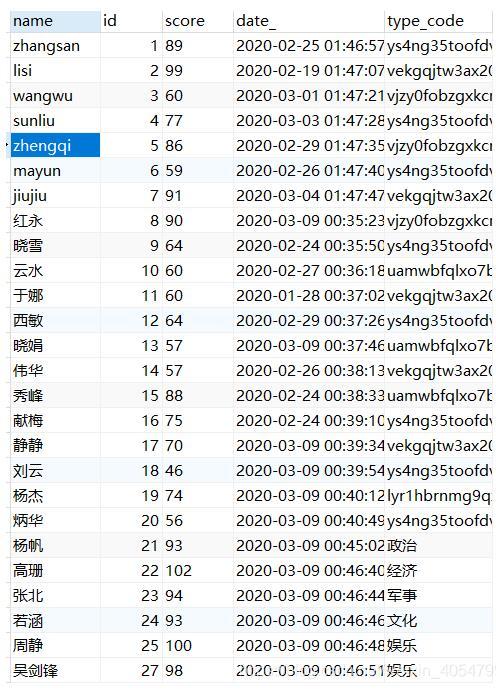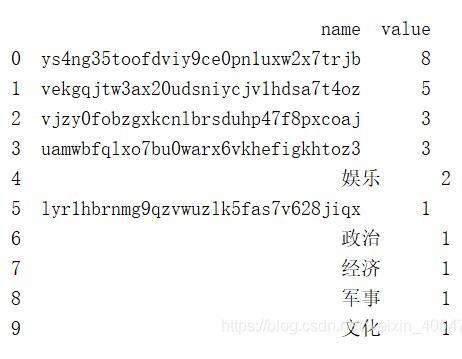数据库中有一字段type_code,有中文类型和中文类型编码,现在对type_code字段的数据进行统计处理,编码对应的字典如下:
{'ys4ng35toofdviy9ce0pn1uxw2x7trjb':'娱乐', 'vekgqjtw3ax20udsniycjv1hdsa7t4oz':'经济', 'vjzy0fobzgxkcnlbrsduhp47f8pxcoaj':'军事', 'uamwbfqlxo7bu0warx6vkhefigkhtoz3':'政治', 'lyr1hbrnmg9qzvwuzlk5fas7v628jiqx':'文化', }
其中数据库的32位随机编码生成程序如下:
string.ascii_letters 对应字母(包括大小写), string.digits(对应数字) ,string.punctuation(对应特殊字符)
import string import random def get_code(): return ''.join(random.sample(string.ascii_letters + string.digits + string.punctuation, 32)) print(get_code()) def get_code1(): return ''.join(random.sample(string.ascii_letters + string.digits, 32)) testresult= get_code1() print(testresult.lower()) print(type(testresult))结果:
)@+t37/b|UQ[K;!spj<(>%r9"PokwTe= igwle98kgqtcprke7byvq12xnhucmz4v <class 'str'>cur.fetchall:
import pymysql import pandas as pd conn = pymysql.Connect(host="127.0.0.1",port=3306,user="root",password="123456",charset="utf8",db="sql_prac") cur = conn.cursor()print("连接成功") sql = "SELECT type_code,count(1) as num FROM test GROUP BY type_code ORDER BY num desc" cur.execute(sql) res = cur.fetchall() print(res)(('ys4ng35toofdviy9ce0pn1uxw2x7trjb', 8), ('vekgqjtw3ax20udsniycjv1hdsa7t4oz', 5), ('vjzy0fobzgxkcnlbrsduhp47f8pxcoaj', 3), ('uamwbfqlxo7bu0warx6vkhefigkhtoz3', 3), ('娱乐', 2), ('lyr1hbrnmg9qzvwuzlk5fas7v628jiqx', 1), ('政治', 1), ('经济', 1), ('军事', 1), ('文化', 1)) res = pd.DataFrame(list(res), columns=['name','value']) print(res)
dicts = {'ys4ng35toofdviy9ce0pn1uxw2x7trjb':'娱乐', 'vekgqjtw3ax20udsniycjv1hdsa7t4oz':'经济', 'vjzy0fobzgxkcnlbrsduhp47f8pxcoaj':'军事', 'uamwbfqlxo7bu0warx6vkhefigkhtoz3':'政治', 'lyr1hbrnmg9qzvwuzlk5fas7v628jiqx':'文化', } res['name'] = res['name'].map(lambda x:dicts[x] if x in dicts else x) print(res)name value 0 娱乐 8 1 经济 5 2 军事 3 3 政治 3 4 娱乐 2 5 文化 1 6 政治 1 7 经济 1 8 军事 1 9 文化 1#分组统计 result = res.groupby(['name']).sum().reset_index() print(result) name value 0 军事 4 1 娱乐 10 2 政治 4 3 文化 2 4 经济 6#排序 result = result.sort_values(['value'], ascending=False) name value 1 娱乐 10 4 经济 6 0 军事 4 2 政治 4 3 文化 2#输出为list,前端需要的数据格式 data_dict = result.to_dict(orient='records') print(data_dict) [{'name': '娱乐', 'value': 10}, {'name': '经济', 'value': 6}, {'name': '军事', 'value': 4}, {'name': '政治', 'value': 4}, {'name': '文化', 'value': 2}]cur.fetchone
先测试SQL:

代码:
import pymysql import pandas as pd conn = pymysql.Connect(host="127.0.0.1",port=3306,user="root",password="123456",charset="utf8",db="sql_prac") cur = conn.cursor() print("连接成功") sql = "select count(case when type_code in ('ys4ng35toofdviy9ce0pn1uxw2x7trjb','娱乐') then 1 end) 娱乐," \ "count(case when type_code in ('vekgqjtw3ax20udsniycjv1hdsa7t4oz','经济') then 1 end) 经济," \ "count(case when type_code in ('vjzy0fobzgxkcnlbrsduhp47f8pxcoaj','军事') then 1 end) 军事," \ "count(case when type_code in ('uamwbfqlxo7bu0warx6vkhefigkhtoz3' ,'政治') then 1 end) 政治," \ "count(case when type_code in ('lyr1hbrnmg9qzvwuzlk5fas7v628jiqx','文化') then 1 end) 文化 from test" cur.execute(sql) res = cur.fetchone() print(res)返回结果为元组:
(10, 6, 4, 4, 2) data = [ {"name": "娱乐", "value": res[0]}, {"name": "经济", "value": res[1]}, {"name": "军事", "value": res[2]}, {"name": "政治", "value": res[3]}, {"name": "文化", "value": res[4]} ] result = sorted(data, key=lambda x: x['value'], reverse=True) print(result)结果和 cur.fetchall返回的结果经过处理后,结果是一样的:
[{'name': '娱乐', 'value': 10}, {'name': '经济', 'value': 6}, {'name': '军事', 'value': 4}, {'name': '政治', 'value': 4}, {'name': '文化', 'value': 2}]补充:今天做测试,用django.db 的connection来执行一个非常简单的查询语句:
sql_str = 'select col_1 from table_1 where criteria = 1' cursor = connection.cursor() cursor.execute(sql_str) fetchall = cursor.fetchall()fetchall的值是这样的:
(('101',), ('102',), ('103',),('104',))上网搜索了一下资料:
首先fetchone()函数它的返回值是单个的元组,也就是一行记录,如果没有结果,那就会返回null
其次是fetchall()函数,它的返回值是多个元组,即返回多个行记录,如果没有结果,返回的是()
举个例子:cursor是我们连接数据库的实例
fetchone()的使用:
cursor.execute(select username,password,nickname from user where id='%s' %(input)result=cursor.fetchone(); 此时我们可以通过result[0],result[1],result[2]得到username,password,nickname
fetchall()的使用:
cursor.execute(select * from user)result=cursor.fetchall();此时select得到的可能是多行记录,那么我们通过fetchall得到的就是多行记录,是一个二维元组
((username1,password1,nickname1),(username2,password2,nickname2),(username3,password3,nickname))以上为个人经验,希望能给大家一个参考,也希望大家多多支持python博客。如有错误或未考虑完全的地方,望不吝赐教。
- << 上一篇 下一篇 >>
python之cur.fetchall与cur.fetchone提取数据并统计处理操作
看: 1501次 时间:2021-05-07 分类 : python教程
- 相关文章
- 2021-12-20Python 实现图片色彩转换案例
- 2021-12-20python初学定义函数
- 2021-12-20图文详解Python如何导入自己编写的py文件
- 2021-12-20python二分法查找实例代码
- 2021-12-20Pyinstaller打包工具的使用以及避坑
- 2021-12-20Facebook开源一站式服务python时序利器Kats详解
- 2021-12-20pyCaret效率倍增开源低代码的python机器学习工具
- 2021-12-20python机器学习使数据更鲜活的可视化工具Pandas_Alive
- 2021-12-20python读写文件with open的介绍
- 2021-12-20Python生成任意波形并存为txt的实现
-
搜索
-
-
推荐资源
-
Powered By python教程网 鲁ICP备18013710号
python博客 - 小白学python最友好的网站!